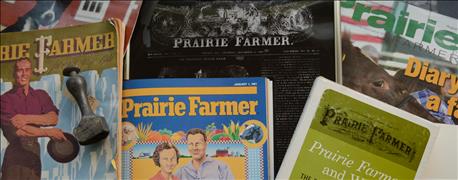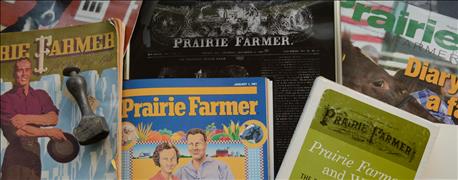October 19, 2016

I found my calling at Prairie Farmer.
Now, after 35 years of interviewing, writing about and photographing farmers, that’s all you really need to know about my connection with this grand old ship.
I was a cocky college kid at University of Illinois in the spring of 1980 when I found out I had been picked for an internship at Prairie Farmer’s editorial office in Decatur. That summer I cautiously ventured into the offices to meet the staff. Intimidated? You bet. Scared? Uh, just a little.

175 YEARS: Celebrating Prairie Farmer, 1841-2016
I was given an assignment — I wish I could remember now exactly what it was. Since it was summer and we were trying to "work ahead," it was likely a story on harvest tips or grain storage. I made some phone calls and went to the library (what, no Google?). I asked my boss, managing editor Gary Reynolds, a thousand questions.
I stared at the blank piece of paper snubbed into my fancy IBM Selectric typewriter. It just stared back. I was terrified.
Finally, I was able to cobble together a few sentences, then a few paragraphs. When I finally decided it was finished, I handed it in. A few hours later, Gary returned that first effort of mine with red pencil marks scratched through nearly every sentence.
“Don’t be discouraged,” he told me. “You’ll get it.”
Really? I thought it was going to be a long summer.
But sure enough, with time and Gary’s tremendous patience, I began to understand what all those red marks meant. How to tighten a sentence, use more powerful verbs and active voice, rewrite the lead using a farmer’s anecdote. I learned the craft of writing, editing and, more importantly, listening. I learned why it’s so important to be direct with readers — they don’t have a lot of time, so get to the point.
Gary taught me a skill that I ended up using in my first job as associate editor at The National Future Farmer magazine, and then later, when I came back to join Prairie Farmer as a staffer. Eventually I served as editor from 1991-2002, during which time the publication won four Editorial Excellence awards in Folio's national magazine contest.
Technology transition
How best to describe Illinois agriculture in the '90s? It was a time when markets finally came back to normal after a difficult era of punishingly high interest rates and farm consolidation. We were transitioning to a technology-driven business. We were just beginning to write the words "precision agriculture" in our headlines. We put on a first-ever conference called Precision Decisions. (I have my late friend and fellow editor Andy Markwart to thank for that clever title.)
I remember interviewing farmers who loved to tinker with those early monitors in the cabs. We’d run photos of farmers with all these wires bulging out from beneath the tractor seat. We wrote our first story about GPS and "satellite farming" sometime around 1995, and the following year, we began writing stories with the words “GMO” and “seed traits.” The magazine championed conservation, and especially no-till. We tried to help farmers look at their farms as a business.
At one point I recall driving through a small Illinois town like the kind I grew up near, in Ogle County, and thought, we should do something to recognize these little towns. So we began a quirky little column in the magazine called Tiny Towns We Love. We’d get a picture of one of those grand old county courthouses or the post office, and write up a few interesting facts about the town and where it got its name. It was another way to honor the communities that make up the fabric of rural America.
One of my best memories is meeting the Master Farmers. I loved the Master Farmer program and still do today, because the award focuses not on production, but on service and family values. We honored farmers for their volunteer work in their churches, schools and farm organizations. They are the servant leaders in every small town in Illinois, and deserve this recognition.
If you like farming and you like people, working at Prairie Farmer is a dream job. The magazine’s mission is to inform and educate, but the truth is, I was the one getting educated. I fell in love with learning, and passing along what I learned in the form of articles and columns.
I made a lot of decisions during my time at Prairie Farmer, but the best by far was hiring a young, talented ag journalism graduate out of University of Illinois for a field editor position in 1998. Unlike me, Holly Spangler needed very little coaching — maybe a few photo tips here and there — and soon began to make a name for herself. Now, as editor, she’s a leading voice in Illinois agriculture. I’d say that was a good hire, one that paid off big time.
The secret sauce
One of the great benefits of my job as editor of Prairie Farmer was to meet so many great farm families who agreed to be interviewed as sources for our stories. The editorial approach we took, and still take, is the same formula John Stephen Wright used when he founded the newspaper back in 1841: “Farmers, write for your paper.” You might say this is our secret sauce. The idea made sense then, and it makes sense today. Sure, we call on university or company experts to fill gaps in our stories, but we know if we want to get the most accurate picture of what is happening on the farm, we must talk to farmers first.
Every editor since Wright lives and breathes one rule: It takes a lifetime to build trust with your audience, and just one day to lose it. So we spend a lot of time making sure we keep building that trust, through honest and accurate reporting. This approach has made Prairie Farmer one of the most respected, most credible publications in agriculture over these 175 years.
While a lot of things have changed about the delivery of information — from newspapers to magazines to the World Wide Web — this formula has never failed. If it’s not broke, why fix it?
Wilson was Prairie Farmer editor from 1991-2002. Today, he is executive editor of Prairie Farmer's sister publication Farm Futures.
You May Also Like




